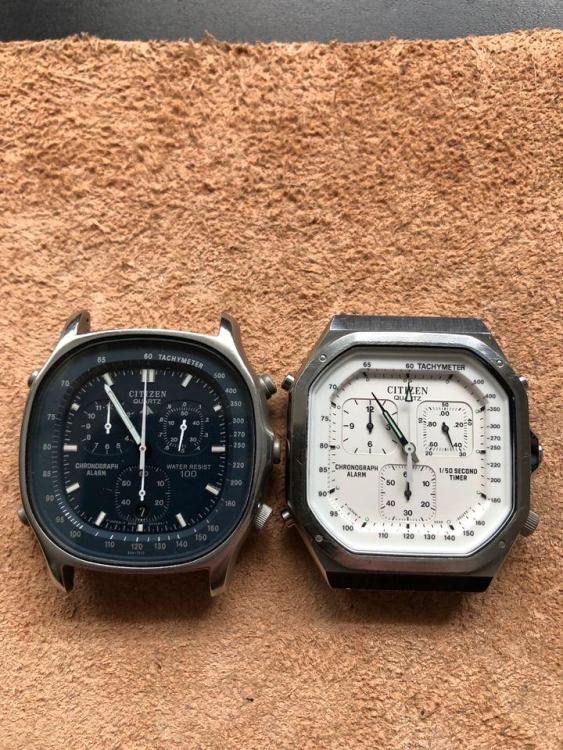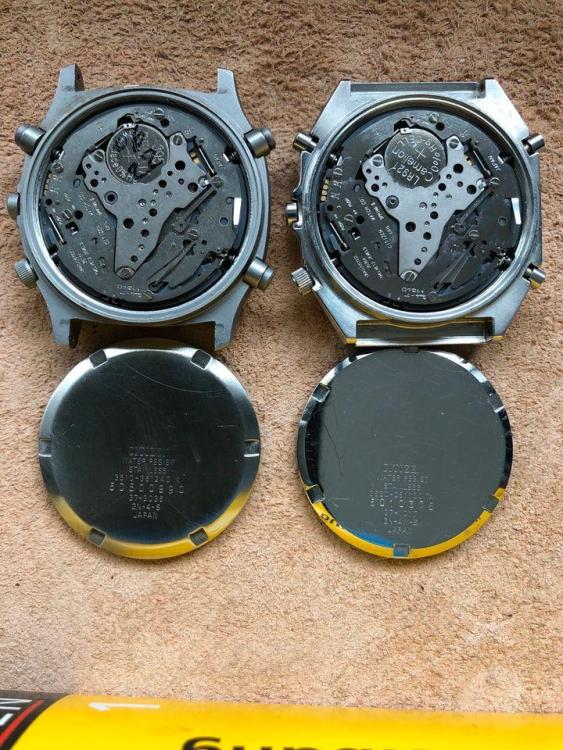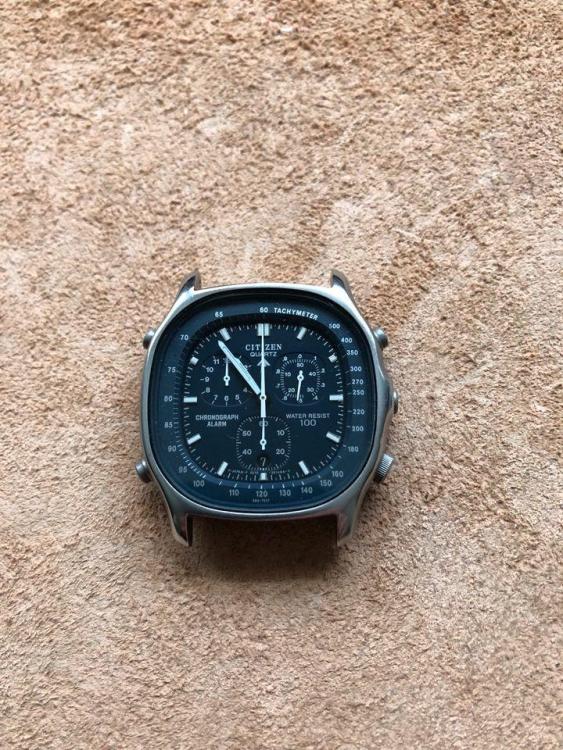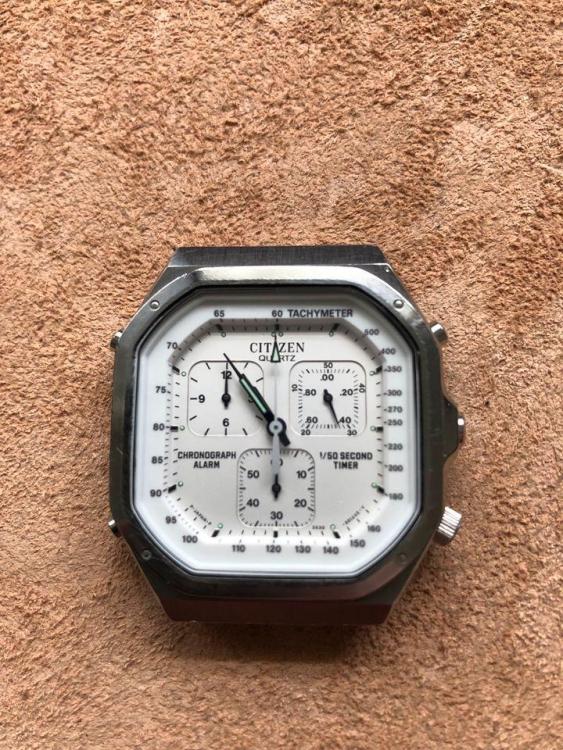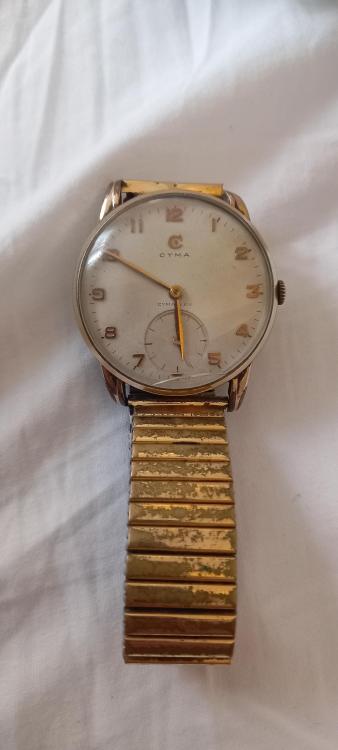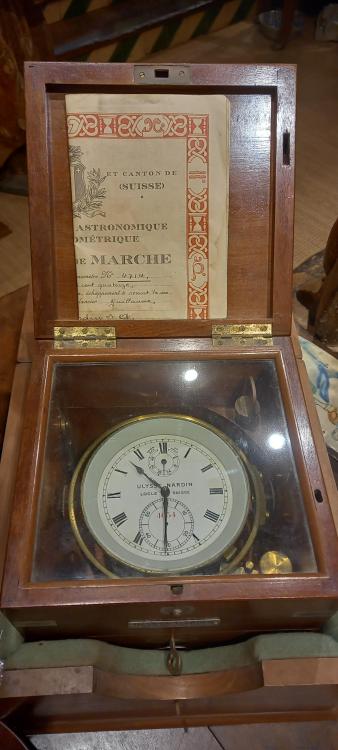Leaderboard
Popular Content
Showing content with the highest reputation on 03/14/24 in all areas
-
one of the problems with multipage discussions is that it makes it hard to go back and reread everything so let's review the process? Did you measure the old staff and the new staff to verify that they're the exact same size? Then riveting despite the fact all the images show one round punch I usually use several of them. In other words I will start with the smallest one I can get start two spread the rivet then I'll do another one slightly larger to keep spreading the rivet or basically whatever it takes. Followed up with a flat punch to just flatten the whole thing out hopefully. The last watch I did didn't flatten out as well as I liked but is held nice and tight so worked fine. actually ended up with a small pile of staking set punches on the bench when doing it despite the fact the photos only show one magical punch I seldom find that works the way it shows in the picture. interesting method not sure I've ever seen it in any book and you really don't one of even begin to grasp what anyone understanding watch repair would think about this method. So if you solder a balance staff PN in a future watchmaker has to replace it is that going to be an issue? if you have a lathe visually the look really nice to impress your friends but they do have purposes in watch repair. Then why don't you start practicing with it and some scrap balance wheels I know hobbyist never practice it takes away the fun but still find some scrap balance wheels look on eBay practice cutting the hubs off see if you like that method. Personally I never did but to each his own. then find some metal start turning it on the lathe maybe make a balance staff a really big balance staff. Watch repair is all about practicing.3 points
-
Wheels are generally rivetted to the pinions, and disassembly would ruin them. Some are friction fit, but again, disassembly would likely lead to a weaker union after reassembly. Best to clean them assembled.3 points
-
a very interesting timepiece inside. Fascinating to watch unfortunately usually very expensive. Then if you have an accident it's usually very expensive to repair. For those not familiar with what it looks like inside here's a short video3 points
-
Actually, the traces are not so erratic, they are periodic. And the periode is something about 4-5 min as I see. In the watchmakers text books, there is a head for timefrapher trace diagnostic, and there one usually finds the short simple answer that the problem is the wheel that turns with the same period. Well, as H. Mencken says, to every complicated problem, a solution will be found - simple, clear and...wrong. The tings that change periodically in the watch movement are more than entire turns of wheels. For ehample, if the 2nd wheel pinion has 12 leafs, 60/12=5 min, so for 5 min the second wheel moves exactly 1 pinion leaf ahead. This is for movements with 2nd wheel in the center and with 12 leaf pinion, which is not the case here, but... Then, periodical rate changes are due preiodical amplitude changes due periodical torque changes, but this actially means that the escapement is not isochronic, so the rate strongly depends on torque. So, if in the first time, the movement is isochronic, then the rate will not so strongly depend on torque and thus on wheel radial trueing or teeth meshing problems. This are only theoretical thoughts. Now, what You have: In the video what i see makes me think that the hairspring is not well centered to the collet. This may lead not only to great periodical changing of studd-hairspring distance and touching when big amplitude, but in the same manner - to touching the hairspring inside coil to the collet too, which also leads to erratic but connected with amplitude rate changes. Then, the other thing is that decrease of amplitude leads to decrease in rate. In such case, the normal thing to do is to close the distance between regulator pins, not to open it more. But it is after cleaning the problem with hairspring center, if it exists. By the way, hairspring off-center leads to 'balance not poised' behavior, is there such thing? Reduce the amplitude by releasing the mainspring and see if the rate/amplitude will get less erratic and if there are ' bad poise' traces ih vertical positions3 points
-
I believe it is a spacer of sorts, it would keep the case-back say or anything from touching or downward pressure and altering the center wheel pivot and/or the regulator since it is also raised, just protection I guess, I have seen this on old Swiss and American movements...3 points
-
Unless you need to cut a new wheel or pinon never take it apart. Diamantine powder with a little oil is good for polishing steel.2 points
-
From experience, no thoughts: friction here can eat much power. It is a kind of hidden fault. Test: without power the pallet must fall from one side to the other by its own weight. Frank2 points
-
This is simple. Make 50 full turns then to be absolutelly sure that the bridle has began to slip. Actually, 6 full turns of ratchet wheel when winding is enough. Now, the spring should be fully wound, at least as much as the bridle resistence alows. Then, release the spring and count the ratchet wheel turns. If they are 6, then the spring has been fully wound. If they are 2 or so, then the briddle slipps earlyer than full wind.2 points
-
the unfortunate problem of most electronic things are visually they can look outstanding and no longer be functional at all. Which is why you need a electronic test equipment to verify that they still have whatever electrical properties there supposed to have.2 points
-
For me, a bit of a "kinky" side step; two partially broken vintage quartz watches no less ! They do run and the chronograph functions do work, but, from both, the small chronograph seconds recorder (1/10 sec) doesn't reset and they don't run I've found some instructions on how to reset the small seconds recorder, but it doesn't say whether the recorder hand should run, or not, after a battery change; "Resetting the Chronograph to Zero: If your chronograph and 1/10 seconds subdial hand are not aligned after a battery change, do not worry as this is common and easily fixed. Simply make sure the crown is in normal position (pressed in against the case), the push Button C (bottom left) twice. The second hand will move, press C again. Pull out the crown to time setting mode. Now you can adjust the two misaligned hands: Button A will advance the central second hand forward, Button B will advance the 1/10 second hand forward. Push the crown back in." So, since both of them do have the same problem, it could be simple and the seller didn't know how to reset, or there could be more to it? Is it a coincidence that both movements do run (cal. 3510 + cal 3530) and do have the same problem ?? They added thrill is that these Citizen / Miyota 3510 movements (12 jewels ! ) are discontinued and apparently (very) hard to get (??). Perhaps one of those: "There is a thin line between a Hero and a Zero" Anyhow, without further ado here some pictures of what should be in the post;2 points
-
Hi Andy. As @Nucejoe said pictures please of the movement. Kenwell maybe the finisher not the maker, pictures of the movement front less dial and hands so we can see the keyless work. We may be able to identify the movement through the Bestfit books. Hove a close look under the balance wheel and on the plates for maikers logo and or calibre number.1 point
-
Do not heat the the bearings. The heat can affect the temper of the bearing steel and also melt the packing grease inside the bearings. The motor shaft needs to be clean and rust free. Sandpaper and steel wool would do an adequate job. You will need a pipe that fits over the shaft loosely to tap the new bearings into the bearing seat. Watch the video below for a clearer explanation.1 point
-
whenever I have timing problems at work usually the first thing I look at is the plot like this and the oscilloscope. I use it to explain why I'm having timing problems. But based on my past knowledge of you and a timing machine I would throw all of this away because you're going to lose your mind and become obsessed about a problem that you may or may not ever be able to fix or a problem doesn't actually exist sort of. yes one of the problems with the watch is a set of gears that in order to produce absolutely linear perfect power ideally shouldn't even be gears at all as gears will always produce pulsations of power. Then if everything isn't exactly perfect like the manufacturing the wheels are slightly out around pivots that don't fit absolutely perfectly or even if somebody furnishes the pivots and are slightly too small soup of flopping around in the whole not by very much conceivably will cause power surges as the tiny bit of the wheels moving around binding up with the gear train. Watches are really interesting things in that the average out a lot of their problems. Timing machines though will show all of these problems that may or may not really be a problem. For instance with this watch does it actually keep time with the hands on? I have a interesting book recommendation is that expensive book I have a video of a book review. It has a nice job of reviewing it it's not a perfect book but it sometimes has its moments. Like for instance there's a section on gears. then it even is a section on the faults of gearing fortunately that's only a couple of pages I could probably scanned that in. Where I'm going with this is watches are mechanical devices gear trains produce power fluctuations watches will still keep really good time with power fluctuations up to a certain points. Be careful not to get obsessed about timing machines software or if you think your first experience with a timing machine was a nightmare this will send you straight to the psychiatric ward. Understand why you're using the software and why you're looking at it. it's amazing how a few words can instantaneously cause of flashback to something in the past which I found to be a pain in the ass. One of my friends had centered his hairspring exactly as you describe and had it perfectly centered exactly as you described. But physically centering without the balance wheel in this case with the Hamilton 992 result of the hairspring that was not flat and not right at all with the over coil. I spent hours of time analyzing trying to figure out where he bent looking at another watch to put the hairspring back right because of what I perceive a stupid method of doing things. The preferred centering is with the balance wheel and hairspring together. Exactly what is described in the first quote above. it's one of the objections I have when people have hairspring issues and everyone says take the balance out of the watch hairspring issues with balance wheels typically occur in the watch you have to be able to see the problem in the watch you don't always have to fix it in the watch but you have to see the problem in the watch balance wheels out of the watch a lot of times a look really nice but not in the watch and collets perfectly centered aren't actually centered at all necessarily.1 point
-
See, the hairspring has a imaginable center. It doesn't exist as some of the spring has been cut to make room for the collet, but even when manufactired, the spring didn't go to it's center. The idea of centering is to adjust the collet position so the collet hole center coincides with the hairspring center. Nothing to do with the spring on the bridge and the collet above the stone. This is done by bending the internal spring coil near the place where it is pinned or attached to the collet. You can imagine the well centered spring as a groove of vinyl record. If the record is centered on the platter, then the arm moves gradually and only to the center when the record plays. If the record has big center hole (45 RPM one) and it is placed not centric on the platter, then the arm constantly moves in/out. Such is the behavior of not centered spring. The centering of the spring to the collet is usually well described in the books where the attaching and pinning the spring to the collet is described. And yes, I mean the spring can touch the collet and this can 'short' the entire internal coil if the spring is not well centered to the collet. Also, not centered to the collet spring brings bad poising to the balance.1 point
-
1 point
-
Watch movements are very complex and inter-related mechanisms. If a tooth is bad, then the periodicity of a problem can simply be related to the time taken for one revolution of that wheel. However, if two interacting wheels have slightly bent pivots, worn jewels or are otherwise less then perfectly centered, it can theoretically be more complex. There can be some points where those problems would add together to bog down the movement, but other times where they could cancel each other out and give better performance. As they rotate at different speeds, those points of deflection would come and go and set up a resonance (for lack of a better term) that would repeatedly occur with a timing different than either of their rotation rates but related to their tooth ratio. Not sure that this would be relevant to your problem, but it seems to me that an issue that occurs somewhat rhythmically over the course of many minutes would be more related to the wheel train than a hairspring problem. But then again, my experience with hairspring manipulation rounds to zero, so you should listen to others!1 point
-
Definitely do not use the case!! I have yet to do mine, but I have read where people put the armature in the freezer and then heat up the bearing before slipping it on. I will probably do that. I may also take some 1000 grit sand paper and remove some of the arbor surface...at least toward the long end-- the bearing only needs to fit tight where it is seated.1 point
-
Hi, I'm just starting out on my own journey of watchmaking. My brother has been a watch enthusiast for quite a while now but I never understood his love towards these curious machines, until now! As mentioned in the title, I live in South Korea and apparently having watchmaking as a hobby is something pretty much unheard of over here. I went to meet a local supplier for watchmaking tools and as I mentioned moebius oils and stuff like that, he was baffled to see a 'hobbyist' looking for such 'professional tools', but I digress... I hope to learn amazing things from all you guys and maybe some ways down the road be able to give back as well.1 point
-
1 point
-
ETA 2892-2 erratic trace I found this post with the erratic trace line seems similar to yours. Happens even on the so modern 2892-2 movement. OP did post a photo of the hairspring with the balance cock flipped upside down, look at it you may think there's plenty of room but no the problem actually lies in the hairspring.1 point
-
This is it. I've seen it on other calibers (jlc in particular). Back in the day casebacks could be very thin, and this guards against influence on the movement.1 point
-
The centering at the collet is actually a big deal. Out of center there can give all kinds of weird results. Not necessarily what you're seeing, but wouldn't surprise me.1 point
-
Yes, the power reserve. But it needs time to see it. There is much faster way to see if the bridle is slipping - that is to count the turns of the ratchet wheel when releasing the spring after it has been fully wound. They should be 6 or about. Removing of the auto works is needed first1 point
-
Just want to pop in and say hi! I have always been eyeing this forum and getting a lot of invaluable knowledge all the time. But now I feel confident I can contribute in some things (Hopefully). Anyways happy watching!1 point
-
Hi @dnhb there are no problems using the device as the spark lasts milliseconds and it’s not UV in any way. If you look on the net for Retrofitting when there is a need. By Wesley R Door you should find the simple device he built. Where about are you located regarding information . Hi just trawl through my memory and a site with all the reagent information is. Dirkfassbender de which gives you all you need to build a stand alone machine or if you wish I can post pictures of how mine is built.1 point
-
how much does the power reserve last from a full wind? Amplitude will be affected if the MS slips very early, and also the power reserve, that's why I suggest taking a look on that. If the power reserve is above 30 hours then it's not a slipping problem.1 point
-
1 point
-
Unfortunately not Nev, an antique shop in Barcelona. I haven't seen one before and at 2800 euros, a couple of pictures was all i was going manage. It is but way more money than i wanted to part with. The shop was quite up market and i didn't have enough cash with me to negotiate for any timepiece.1 point
-
Watch newbie here, ready to learn a lot of things and hopefully will be able with some knowledge to teach others as well later on1 point
-
This points to a broken pivot. With an oiler gently lift one side of balance wheel as you keep an eye on pivots, in case a pivot don't stay in jewel hole its broken. Better yet is detaching balance complete from the cock and show a close up side view of pivots. Rgds1 point
-
I have experience with enamel dials. The base metal is copper. They can easily bear heating to 500 degr. celsius with no damage. But they can't survive sudden local heating while the rest of the dial is cool. The enamel on this local heated place breaks. If You solder melts at about 180 degr., then You need to heat the whole dial to 150-60 degr and hold it on this temperature, then it can be soldered easily with normal soldering iron (for electronic components soldering) without danger of damaging the enamel. You heat a big metal plate to constant 160 degr. and put the dial on it, wait for a while so the dial heats from the plate and then solder the leg(s) with the soldering iron. If the plate is to hot, then the solder will not harden, so You will not be able to solder the second leg without loosing the position of the first one. If it is to cool, then it will be very hard to heat the leg place on the dial enough so the solder will melt there.1 point
-
Not long ago there was a discussion about a tool for grinding the bottom part of the staff togrther with the hub This is on the same principle as @Delgetti uses with His method. This tool is usefull specially for those who don't have or use lathe. I have seen similar self made tools in the russian forum and will try to give link here if manage to find the thread. Here is link with images of one http://forum.watch.ru/showpost.php?p=2410366&postcount=101 point
-
Hello and welcome to the forum. Have you t4ied thepocketwatchdatabase. With the serial number for starters1 point
-
1 point
-
Hi, got hooked when i stumbled upon Alex’s youtube channel and i was looking to restore my uncle’s Longines and Omega that i inherited. setup my watchmaking corner and been practicing on an ST36. Glad to joining the community.1 point
-
OK, I made some videos to show that drilling hardened still is normal thing, when tungsten carbide drill bits are used. Actually, this is the same as turning hardened steel on the lathe - this is normal practice in watchmaking. On the video with clock spring - this is 0.35mm thick spring, as hard as a spring can be. There are two interrupts in the video - that was for sharpening the bit. On the second one, which was at the end of drilling, the tip of the bit chipped. This happens, and for avoiding it, something must be put under the piece, with close hardness, and the piece should be pressed to it. The video with the old rusty filler gauge shows that it is much easier to cut. The gauge is 0.3mm. This gauges usually are made of spring steel, which is something totally different from normal carbon tool steel, and annealing it usually can't bring it as soft as carbon steel. See, heat treatment of steel is another, not simpe skill, craft... Annealing always leads to burning carbon int the steel and not only, then hardening and annealing can easy ruin the still and make it really crunchy if overheated. It usually takes many hours of practice to learn how to heat treat, and every different kind of steel has it's own ways and rules. So, this is much much easier to use readily heat treated steel and shape it in this state. Shaping is easy with carbon dental separators on the dremel tool, then fine with diamond files.1 point
-
I also use pinvice, one that has cap like screwdriver. OK, I will make a video and will make holes on not anealed watch spring, filler gauge... When making holes on the lathe, I prefer to hold the drill bit and press it to the work with fingers, and no big speed is needed. I use special tool that leads the bit to the work center. I have shown this repivoting techic here, the same kind of drill bit 0.25mm used in the video.1 point
-
Guys, this is stange that You search for the hardest way to do the job. The drills mentioned abowe drrill hardened steel with no need of anealing, like piece of cake. I will make video to show how. I see one mistake here of making the lever: The first thing to do is to plase the broken lever on the material and drill the holes thru it as a conductor. Then - to put tapered pins in the holes that will hold the old lever on the material, to drow the contures with sharp tool, and only then - to start cutting1 point
-
There is no doubt that stereo microscopes are gaining ground. I am currently following a youtube channel from a watchmaker's workshop in the Netherlands (ChronoGlide). They repair vintage watches and also teach students. In their workshop, they actually only use microscopes!1 point
-
This is arguably almost as much a benefit as the improved visibility. Watchmaking benches are rare and expensive; much more expensive than a microscope. You can rig up a tall work surface to save your neck, but then your arms/shoulders are the next in line of contortion. I went the opposite direction initially, and bought a cheap wooden stool from IKEA, then chopped the legs off to make it short. Cheaper than raising or a raised work surface. Still had the arms/shoulder issue, but then add that I either needed to really be able to stretch out my legs, or my knees were on the list of contortion. With the 'scope, I'm at a perfectly serviceable work height all around. There are three things that keep me from watchmaking: one is the physical discomfort (solved), two is the eye strain/inability to really see what I'm doing (solved), and the third is just finding time (constant struggle).1 point
-
Sorry about that/you're welcome. I started out answering the part about the 10% sale, but accidentally linked to the part number breakdown post, then saw the thing about the part number quagmire, and things devolved. We started potty training our 2 year old this weekend, and it's been a long day. 15% comes up from time to time, check out the Wayback Machine on obvious time periods, and you'll be able to figure when to wait for. Re: 20x eyepieces, they came in handy this past week in a non-child way. I listen to a lot of vinyl, and we had a record that was skipping. I recalled reading a few years back that it might be possible to repair a skipping record. Tons of caveats; You have to know what you're doing, be super careful, guess right, etc. I figured I could probably eliminate a lot of the guesswork if I could see it. I saw what was likely my skipping scratch, and got up on it with the microscope, but nothing... I turned the album around on the offending track a while, and then I found the problem... A dust mote wasn't actually a dust mote, but some hard bit of ash or something that melted into a groove, and was really stuck in there! I grabbed my 0.5mm watchmaking screwdriver, dropped it in the groove like a needle, and popped that hard little thing out! No more skip! Excellent tool!1 point



